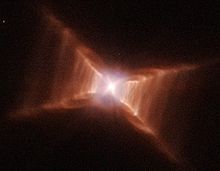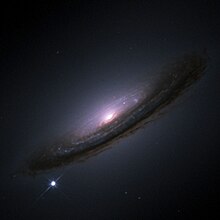Stellar astrophysics
The study of the physics of stars is called Stellar Astrophysics; its formation, evolution and end, as well as its properties and distribution.
A fundamental tool in the study of stars is the Hertzsprung-Russell diagram.
The study of stars and their evolution is essential to advance our knowledge of the universe, since they constitute the basic modules that make it up. Stellar astrophysics makes use of observational and theoretical understanding, as well as numerical simulations of the internal composition of stars.
Birth and life of a star
Star formation occurs in dense regions of molecular dust and gas, known as interstellar nebulae. The force of gravity pulls the hydrogen atoms towards the center of the accumulation, making it more and more dense. There comes a point where their velocities are so great that the proton from a hydrogen nucleus manages to overcome the electrical repulsion of the nucleus it hits, fusing with it and others to form a stable helium nucleus.
A star from its birth has different phases of evolution. In its early stages as an embryo it is surrounded by the remains of the gas cloud from which it formed. That gas cloud is gradually dissipated by the radiation emanating from the star, possibly leaving behind a system of smaller objects like planets, etc.
After the stage of infancy, a star enters its maturity, which is characterized by a long period of stability during which, in its core, hydrogen is converted into helium, releasing enormous amounts of energy. This stage of stability of the star is called the main sequence.
The characteristics of the resulting star will depend on the magnitude of its mass. The more massive the star, the greater its luminosity and the faster it will exhaust hydrogen from its core, making it brighter, larger, and hotter. The rapid fusion of hydrogen into helium also implies a depletion of the former's reserves sooner in massive stars than in smaller ones. For a star like the Sun, its stay on the main sequence is about 10 billion years; a star ten times as massive will be 10,000 times brighter but will last on the main sequence for only about 100 million years.
When all the hydrogen in the star's core has been converted to helium, the star will begin its development. Helium fusion requires a higher core temperature, so the star will increase both in size and core density.
Evolution and death of a star
Not all stars evolve in the same way. The mass of the star is, once again, decisive when carrying out a study on the different phases that it experiences throughout its life.
Small Mass Stars
These types of stars are long-lived. Our knowledge about its evolution is mere theory, since its stage in the main sequence lasts longer than the current age of the universe. Astrophysicists consider that they should have an evolution very similar to intermediate-mass stars, except that in the final phase the star would cool down, becoming a black dwarf after a billion years.
Intermediate Mass Stars
Our Sun lies within this division. They are stars that during the main sequence phase transmute hydrogen into helium in their central core, but the first, in millions of years, is gradually depleted until reaching an instant in which the fusions are insufficient to generate the necessary pressures to balance the gravity. Thus, the center of the star begins to contract until it reaches such a high temperature that the helium melts and turns into carbon. The remnant of hydrogen lodges as a shell burning and transmuting into helium and the outer layers of the star expand. That expansion makes the star a brighter and cooler red giant than it was in its main-sequence stage.
During this phase, a star loses many of its outer layers which are ejected into space by the radiation it emanates. Eventually, the most massive stars of this type manage to ignite the carbon so that it is transmuted into heavier elements, but the normal thing is that the star collapses inward due to the pressure of gravity, transforming itself into a white dwarf.
Higher Mass Stars and Massive Stars
They are fast-burning stars. The short length of their lives makes the big stars strange, since only those formed in the last 30 million years - and not all of them - still exist.
At first they quickly pass through almost the same phases as an intermediate-mass star, but massive stars have cores so hot that they transmute hydrogen into helium in a different way, using leftover carbon, nitrogen, and oxygen. Once the star has exhausted the hydrogen in the core and housed the remnants of the core as husks, it enters a phase known as a red supergiant. When their cores have been converted to helium, the stars' enormous gravity allows fusion to continue, converting helium to carbon, carbon to neon, neon to oxygen, oxygen to silicon, and finally silicon to iron. At this point, as the iron does not fuse, the star's core collapses, resulting in a supernova explosion.
The remnant of a supernova is generally thought to be a neutron star. A pulsar in the center of the Crab Nebula is now identified with the core of the 1054 supernova. In the event that the persistent mass of the star is two to three times that of the Sun, the contraction will continue until it forms a black hole.
Binary stars can follow much more complex models of evolution, could transfer part of their mass to their companion and generate a supernova.
Planetary nebulae and supernovae are very necessary for the distribution of metals through space, without them, all new stars (and their planetary systems) would be made exclusively of hydrogen and helium.
Contenido relacionado
Roche limit
Phobos (satellite)
Millimeter


